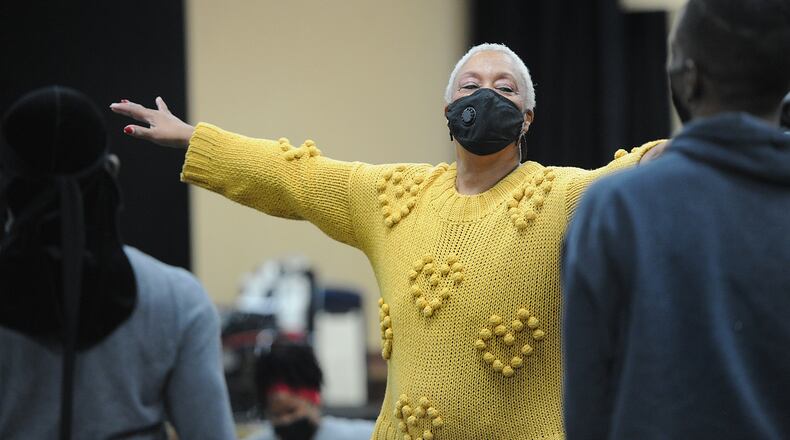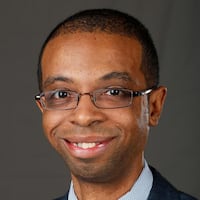The daughter of groundbreaking DCDC founder Jeraldyne Blunden (1940-1999), Blunden-Diggs has been at the forefront of the world renown organization since becoming artistic director in 2007. A gifted artist acclaimed for her work in her teens, her fluid and fierce choreography has been featured over the decades in such works as “Configurations,” “Fragments” and “In My Father’s House.” In 2019, she received the fourth annual Black History Month Congressional Award for Community Service by Congressman Mike Turner in recognition of 40 years serving the community through dance and dance education.
Her indelible imprint within DCDC also covers multiple facets: associate artistic director, deputy director for arts and operations, resident choreographer, and executive director of Jeraldyne’s School of the Dance. She also keeps a close watch on DCDC2, the company’s pre-professional troupe.
In many respects, the 61-year-old is the lifeblood of the company, ensuring its passion, purpose and vitality for the next generation of dynamic dance artists choosing to work within the flavorful history and movement of the African American idiom.
In advance of DCDC’s presentation of “Inside Out,” slated Feb. 26-27 at the Victoria Theatre, the Dayton native reflected on her storied career, the importance of the company’s Dayton roots, and her vision for the future of the company, which is celebrating its 53rd season.
Q: When did you realize you loved dance and wanted to be a dancer?
A: My parents were very instrumental in making sure my brother and I had a broad education. So, of course, dance was part of that. And, actually, I danced but he never did. My brother was a stellar athlete. But I started to dance at a young age and enjoyed it enough and never rebelled against it. I didn’t choose dance – dance chose me. I continued to do it and it chose me. I joined this company when I was 12 years old. When I was 15, I started teaching and choreographing. When I was 16, I received some major acclaim choreographing. I loved creating from a really young age. In the summers, I studied in New York for two months. When I got to high school, I ran into some social challenges such as rehearsing instead of going to a basketball game. I didn’t even go to a prom because we were always performing somewhere. But luckily for me, I never felt alone. And in 1976, (jazz musician) Roy Meriwether, who passed away not too long ago, created a beautiful, evening-length composition called “Black Snow” in honor of the bicentennial performed at Memorial Hall. It was my first experience in a true collaboration. I was 16 and it was the first time we earned a check for performing. I thought, “I can do this and get paid for it!?” Some of us were also asked when we were going to New York. But that was never the destination. Being here and making DCDC everything it could be here was our destination. That was Jeraldyne’s goal from the beginning. And now we have dancers who come here who start and finish their careers here – this is their destination, which speaks to the amazing legacy of this company. My husband and I have really deep roots here and we’ve raised our kids here. It’s been a good life.
Q: What currently inspires your love of dance?
A: Watching younger artists come into the space and knowing I can be instrumental in helping them plot their course whether they stay here for their career or whether they spend a couple of seasons here and go someplace else. Knowing that as a creator, as a practitioner of the art form, I’m a dancer’s dancer. I sit as chief artistic and producing director of this company, but there is never a decision I make that doesn’t put the dancers first because I was them. I tell them that all the time. I don’t ask them to do anything I wasn’t asked or wouldn’t do. When I started dancing and then choreographing, my mind was about the dance, whether the dance was seven or 20 minutes long. But now it’s about the project. Right now, it’s about the totality of “Inside Out.” What can I bring together that will explode in magic not just for me but for everybody? As an organization that’s 53 years old, our responsibility is to continue to be valid, continue to curate and challenge our dancers, and continue to challenge our audiences.
Q: Looking back on your time with the company, what have been some of your proudest achievements?
A: The DanceMotion’s USA tour in 2018. For 31 days, eight dancers, our company manager, our production director and I were between Russia and Kazakhstan. Nothing compares to the experiences and memories we had there. Other proud moments were “Revisioning 45,” a program of all-new dance pieces, and “The Bench,” in which nobody could see the end result like I could, and we looked totally different as a company doing it. I’m also proud of us making it through COVID, being able to keep dancers employed and do work by shifting to digital content. By the time we sheltered in 2020, my goal for the company was to come out of it stronger, not wounded and injured. And when we took the Levitt Pavilion stage last August, we were stronger.
Credit: CONTRIBUTED/DAVID A. MOODIE
Credit: CONTRIBUTED/DAVID A. MOODIE
Q: What have been some of your biggest challenges?
A: Next year, I’ll be with this company for 50 years. A nonprofit organization is already hard. To be an African American nonprofit arts organization takes you down the rung. But no matter how mad I am or defeated I feel sometimes, to still be able to know I still have work to do, and there are still dancers I think I can impact, I will continue to do this in a community that raised me and for the larger dance community that raised me. I sat at their feet and was the recipient of their wisdom and their pushes.
Q: You’ve said in the past that you felt more people know about DCDC outside Dayton than in Dayton? Isn’t that a challenge? Perhaps a matter of Dayton taking DCDC for granted?
A. It’s a challenge but it’s no different than the funk music culture that came out of Dayton. Receiving recognition in your hometown is tough. Because L.A. and New York City have been the levels of success people can see, the thought is “You can’t be so-and-so if you’re only in Dayton.” But it’s not true. And it’s not just DCDC – think about Paul Laurence Dunbar.
Q: What are some of your future goals for DCDC?
A: We’re creating a project called Convergence. We’re collaborating with James Surls, a sculptor from Texas. He has amazing life-sized sculptures – 20 feet by 20 feet, 30 feet by 15 feet – that we’re going to build a performative event around. We’re going to converge the two art forms in practicality but in time, space and place. The projective date is the fall of 2024.
Q: It really feels like you want DCDC to evolve and expand.
A: We’re (53) years old and I still want to be the leader in how dance is presented. I think five years from now, the performances that happen in your traditional, proscenium stage space will, in some ways, become elitist again because of the pricing. But the art form belongs to everybody. It’s about trying to figure out how to be accessible whether through community impact (programming) or educational programs. DCDC is a Black dance company rooted in the African American experience, so I never want to not be accessible to somebody because it costs too much. What we have to offer is too great and too important to be divided because of the price of admission.
Q: Are there any words of wisdom you continue to apply perhaps from your mother or from your own creative path?
A: Never stop. Don’t let anybody tell you that you can’t do something. You have to really push through for what you believe. And you’re not going to be right all the time. You’re going to make mistakes and have some duds. Yesterday, I thought about a performance we did six or seven years ago that was horrible – not the dancers but the dances and where we were performing. But we strive to be excellent at all times. And the dancers believe in the legacy, and they believe in me. I’m not in this by myself at all – ever.
HOW TO GO
What: “Inside Out”
Where: Victoria Theatre, 138 N. Main St., Dayton
When: Feb. 26-27; 7:30 p.m. Saturday and 4 p.m. Sunday
Cost: $33-$53
Tickets: Call 937-228-3630 or visit daytonlive.org
FYI: Patrons are required to wear masks
SPECIAL COVERAGE: This is part of a series of Life & Arts stories celebrating Black History Month.
Jan. 30: ‘Black Life as Subject Matter II’ ranges from everyday life to protest
Feb. 6: Smithsonian curator has Dayton-area roots
Feb. 13: Oscar-winning, Centerville-raised Wright State grad reflects on career
About the Author









